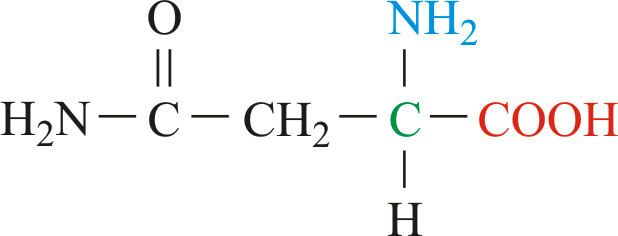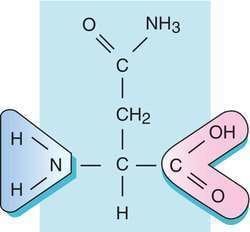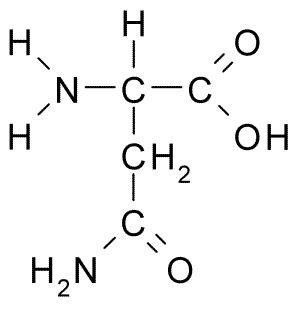Formula C4H8N2O3 Density 1.543 g/cm³ | Molar mass 132.1179 g/mol Appearance white crystals | |
 | ||
Thermodynamicdata Phase behavioursolid–liquid–gas | ||
Asparagine aspartate catabolism to oxaloacetate
Asparagine (abbreviated as Asn or N), encoded by the codons AAU and AAC, is an α-amino acid that is used in the biosynthesis of proteins. It contains an α-amino group (which is in the protonated −NH+
3 form under biological conditions), an α-carboxylic acid group (which is in the deprotonated −COO− form under biological conditions), and a side chain carboxamide, classifying it as a polar (at physiological pH), aliphatic amino acid. It is non-essential in humans, meaning the body can synthesize it. A reaction between asparagine and reducing sugars or other source of carbonyls produces acrylamide in food when heated to sufficient temperature. These products occur in baked goods such as French fries, potato chips, and toasted bread.
Contents
- Asparagine aspartate catabolism to oxaloacetate
- History
- Structural function in proteins
- Degradation
- Function
- References

History

Asparagine was first isolated in 1806 in a crystalline form by French chemists Louis Nicolas Vauquelin and Pierre Jean Robiquet (then a young assistant) from asparagus juice, in which it is abundant, hence the chosen name. It was the first amino acid to be isolated.

Three years later, in 1809, Pierre Jean Robiquet identified a substance from liquorice root with properties he qualified as very similar to those of asparagine, and that Plisson identified in 1828 as asparagine itself.
Structural function in proteins

Since the asparagine side-chain can form hydrogen bond interactions with the peptide backbone, asparagine residues are often found near the beginning of alpha-helices as asx turns and asx motifs, and in similar turn motifs, or as amide rings, in beta sheets. Its role can be thought as "capping" the hydrogen bond interactions that would otherwise be satisfied by the polypeptide backbone. Glutamines, with an extra methylene group, have more conformational entropy and thus are less useful for capping.

Asparagine also provides key sites for N-linked glycosylation, modification of the protein chain with the addition of carbohydrate chains. Typically, a carbohydrate tree can solely be added to an asparagine residue if the latter is flanked on the C side by X-serine or X-threonine, where X is any amino acid with the exception of proline.
Degradation

Asparagine usually enters the citric acid cycle in humans as oxaloacetate. In bacteria, the degradation of asparagine leads to the production of oxaloacetate which is the molecule which combines with citrate in the citric acid cycle (Krebs cycle). Asparagine is hydrolyzed to aspartate by asparaginase. Aspartate then undergoes transamination to form glutamate and oxaloacetate from alpha-ketoglutarate.
Function
Asparagine is required for development and function of the brain. It also plays an important role in the synthesis of ammonia.
The addition of N-acetylglucosamine to asparagine is performed by oligosaccharyltransferase enzymes in the endoplasmic reticulum. This glycosylation is important both for protein structure and protein function.
